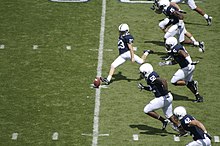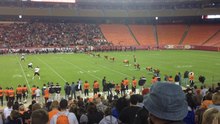Kickoff (American Football)

A kickoff , a type of free kick , is a special move in American football , Canadian football, and arena football . At the beginning of each half of the game and an overtime , but also after a touchdown and after each field goal , the kickoff specialist of the kicking team puts the ball into play with a mostly long shot (exception: after a field goal in Canadian football, if desired of the receiving team, the kickoff can also be replaced by starting directly at their own 35-yard line).
In wheelchair football , the kickoff is simulated by a forward pass. After a safety there is a safety kick , another type of free kick.
In both forms of kicks usually the other team gets ( Receiving Team ) the possibility of returns , where the ball is carried back as far as possible. If the ball goes into touch at the kickoff, beyond the end zone or if the ball catcher signals a fair catch , the right to attack changes without a return.
execution
In the normal kickoff, the so-called kicking team separates from possession and shoots the ball from its own 35- yard line (in the NFL up to the 2011 season from the 30-yard line) from a kicking tee , a support for the ball, as far as possible in half of the opponent. Until the kickoff, all players on the kicking team stand behind their own 35-yard line, mostly distributed along this line. The players of the receiving team are at least ten yards from the 35-yard line, distributed throughout the playing field up to their own end zone. Some of them can also stand right on the line to ward off an onside kick .
The kicking and receiving team are formations of the special teams that are neither part of the offense nor the defense .
The ball may be captured by the receiving team immediately after it has been kicked . The kicking team is only allowed to do this if the ball has been touched by an opposing player or has covered at least ten yards.
Then there are six possible game continuations:
- The ball flies over the end zone or lands there untouched by the receiving team on the ground: This means that the play is ended immediately and after this touchback the receiving team is given the right to attack its own 20-yard line (since 2016 at the 25-yard Line, see touchback). The same applies if the ball is caught directly from the air by a player of the receiving team in the end zone, but is not carried back because the ball catcher goes on his knees and thus ends the play or carries the ball forward, but still in the end zone is tackled (no return out of the end zone).
- The ball catcher signals a fair catch by clearly waving one hand above his head . He must not be disturbed while catching the ball, but he must not run a return either . Instead of catching the ball, the receiving team has the right to attack.
- The ball catcher does not wave, catches the ball and moves towards the opposing end zone ( kickoff return ). This turn is over when the kick returner leaves the field, is tackled , or scores a touchdown .
- The ball goes into touch between the end zones without being touched by a player on the receiving team . This is considered a foul.
- If the onside kick is attempted for the first time, there is a five yard penalty for the kicking team and a new kickoff.
- With the second consecutive onside kick into touch (as well as when the kicking team touches the ball in the second attempt before the ball has covered ten yards), the receiving team receives the right to attack at the point where the ball went into touch or there, where the ball was touched too early or the play ended.
- If no onside kick was attempted, the receiving team is granted the right to attack 30 yards from the point of the kick or at the point where the ball went out of touch.
- The ball goes into touch after being touched by a player on the receiving team . The receiving team receives the right to attack at the point where the ball went out of touch.
- The ball is captured by a player from the kicking team (see onside kick ). This retains the right to attack at the point of conquering the ball. If the kicking team captures the ball in the opposing end zone, it scores a touchdown .
Special kickoffs
During the onside kick , the kicking team tries to keep possession of the ball. To do this, it must capture the ball after it has been touched by a member of the receiving team or has traveled at least ten yards. Since the receiving team is already allowed to stand there and the ball is shot to them, they rarely succeed in capturing an onside kick. It is therefore usually only used when the team urgently wants to score points towards the end of the game and the opposing offense could let the playing time run out with its attack series. A typical strategy to increase the chances of winning the ball is to switch the players of the kicking team to one side of the kicker shortly before the kick, combined with a landing shot, which makes the path of the bouncing ball difficult to predict and forbids a fair catch . Alternatively, this heavily occupied side sometimes only serves as a fake : the kicker shoots the ball to the side where only one or two of its own players are standing, or pushes it forward ten yards with a loose shooting in order to conquer it himself. If the kicking team captures the ball on the onside kick, the ball may not be carried further and the offense drive starts from the point at which the ball was captured. A common tactic of the receiving team against an onside kick is to set up a hands team (hand team), which consists of the most reliable players.
The Squib Kick is a flat, hard press hit in which the football jumps over the ground in a hardly predictable way due to its egg shape. Compared to a normal kickoff, the Squib Kick is shorter, so it usually gives the receiving team a good field position. It is mainly used when you want to avoid a particularly fast and dangerous kick returner from your opponent. The Squib Kick is difficult to bring under control and usually does not end up with the fastest returner, so the risk of the opponent making a long return or even a touchdown is lower.
Penalties and special features
If a player on the receiving team crosses the bounding line before the kick, there is a five yard penalty and a new kickoff. If a player on the kicking team crosses the line on which the ball is lying before it is shot, the receiving team can choose whether there is a five-yard penalty and a new kickoff or whether the return counts and the five yards on the At the end of the turn.
If the ball does not make ten yards at the kickoff and is not touched by a player on the receiving team , there is a five-yard penalty and a new kickoff. With the second attempt of an onside kick that does not make the ten yards and has not been touched by a player from the receiving team , the right to attack changes at the point where the ball remains or was secured by the kicking team.
If the ball catcher at the fair catch disturbed in receiving the ball or even tackled, there is a 15-yard penalty. The penalty also applies if the ball catcher signals a fair catch, but only uses this to block a player on the kicking team . By signaling a fair catch, the player is not forced to catch the ball, but he must not have any contact with an opponent before the ball has been touched by someone else.
No field goal can be achieved at the kickoff - this is only possible with one move within the four attempts (downs) of the offense . If the ball is kicked through the opponent's goal posts, there is a touchback .
Timekeeping: With the kickoff, the game clock does not start when the kick is executed, but only and only when the ball is caught by the receiving team in the field of play or is carried into the field from the end zone. When the kickoff turn is over, the clock (if it is running) always pauses.
Distances and penalties in other leagues
The positions, distances and penalties shown above are in accordance with National Football League (NFL) rules . The values in other countries and leagues differ slightly from these.
return
Of the players of the receiving team , with an expected normal kickoff, one or two players stand particularly deep in their own half, depending on the opposing kickoff specialist and his shot power, also on or in their own end zone.
The kick returner catch the ball and carry it back as far as possible towards the opposing end zone. The other players on the receiving team act as blockers for the returner. The return ends when the returner leaves the field, is tackled or scores a touchdown .
As with the running game , no forward passes are allowed on the return . The player in possession of the ball may, however, hand over the ball with a lateral pass .
If the returner drops the ball while catching it (including a fair catch ), this remains a free ball and it can be captured by any team. If he drops it on the return, this is a fumble and the ball can also be picked up by any team. When the kicking team conquers the free ball , the turn ends at the point where the ball was captured. On the other hand, if the kicking team wins a fumble, it may carry the ball on until the turn ends.
literature
- Bowy, Knitter, Rosenstein: American football - from kick-off to touchdown. Weinmann, Berlin 2002, ISBN 3-87892-054-7 .
swell
- ↑ Football Canada (Ed.): Touch Football Rule and Case Book . 2013, p. 65 : "Each half will begin by a kick-off (simulated by a forward pass) from the kicking team's 20 yard line."
- ↑ a b NFL moves kickoffs to 35-yard line; touchbacks unchanged , accessed August 16, 2015.
- ↑ a b http://operations.nfl.com/the-rules/2015-nfl-rulebook/#rule6
- ↑ http://operations.nfl.com/the-rules/2015-nfl-rulebook/#section-2-fair-catch


